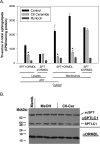The ORMDL/Orm-serine palmitoyltransferase (SPT) complex is directly regulated by ceramide: Reconstitution of SPT regulation in isolated membranes
- PMID: 30700557
- PMCID: PMC6442065
- DOI: 10.1074/jbc.RA118.007291
The ORMDL/Orm-serine palmitoyltransferase (SPT) complex is directly regulated by ceramide: Reconstitution of SPT regulation in isolated membranes
Abstract
Sphingolipids compose a lipid family critical for membrane structure as well as intra- and intercellular signaling. De novo sphingolipid biosynthesis is initiated by the enzyme serine palmitoyltransferase (SPT), which resides in the endoplasmic reticulum (ER) membrane. In both yeast and mammalian species, SPT activity is homeostatically regulated through small ER membrane proteins, the Orms in yeast and the ORMDLs in mammalian cells. These proteins form stable complexes with SPT. In yeast, the homeostatic regulation of SPT relies, at least in part, on phosphorylation of the Orms. However, this does not appear to be the case for the mammalian ORMDLs. Here, we accomplished a cell-free reconstitution of the sphingolipid regulation of the ORMDL-SPT complex to probe the underlying regulatory mechanism. Sphingolipid and ORMDL-dependent regulation of SPT was demonstrated in isolated membranes, essentially free of cytosol. This suggests that this regulation does not require soluble cytosolic proteins or small molecules such as ATP. We found that this system is particularly responsive to the pro-apoptotic sphingolipid ceramide and that this response is strictly stereospecific, indicating that ceramide regulates the ORMDL-SPT complex via a specific binding interaction. Yeast membranes harboring the Orm-SPT system also directly responded to sphingolipid, suggesting that yeast cells have, in addition to Orm phosphorylation, an additional Orm-dependent SPT regulatory mechanism. Our results indicate that ORMDL/Orm-mediated regulation of SPT involves a direct interaction of sphingolipid with the membrane-bound components of the SPT-regulatory apparatus.
Keywords: cell signaling; endoplasmic reticulum (ER); homeostasis; lipid metabolism; lipid signaling; phytoceramide; sphingolipid; sphingomyelin; sphingosine.
Conflict of interest statement
The authors declare that they have no conflicts of interest with the contents of this article
Figures







Similar articles
-
Transmembrane topology of mammalian ORMDL proteins in the endoplasmic reticulum as revealed by the substituted cysteine accessibility method (SCAM™).Biochim Biophys Acta Proteins Proteom. 2019 Apr;1867(4):382-395. doi: 10.1016/j.bbapap.2019.01.005. Epub 2019 Jan 10. Biochim Biophys Acta Proteins Proteom. 2019. PMID: 30639427 Free PMC article.
-
Orm/ORMDL proteins: Gate guardians and master regulators.Adv Biol Regul. 2018 Dec;70:3-18. doi: 10.1016/j.jbior.2018.08.002. Epub 2018 Aug 31. Adv Biol Regul. 2018. PMID: 30193828 Free PMC article. Review.
-
ORMDL/serine palmitoyltransferase stoichiometry determines effects of ORMDL3 expression on sphingolipid biosynthesis.J Lipid Res. 2015 Apr;56(4):898-908. doi: 10.1194/jlr.M057539. Epub 2015 Feb 17. J Lipid Res. 2015. PMID: 25691431 Free PMC article.
-
The ORMs interact with transmembrane domain 1 of Lcb1 and regulate serine palmitoyltransferase oligomerization, activity and localization.Biochim Biophys Acta Mol Cell Biol Lipids. 2019 Mar;1864(3):245-259. doi: 10.1016/j.bbalip.2018.11.007. Epub 2018 Dec 6. Biochim Biophys Acta Mol Cell Biol Lipids. 2019. PMID: 30529276 Free PMC article.
-
Regulation of de novo sphingolipid biosynthesis by the ORMDL proteins and sphingosine kinase-1.Adv Biol Regul. 2015 Jan;57:42-54. doi: 10.1016/j.jbior.2014.09.002. Epub 2014 Sep 17. Adv Biol Regul. 2015. PMID: 25319495 Review.
Cited by
-
An ERAD-independent role for rhomboid pseudoprotease Dfm1 in mediating sphingolipid homeostasis.EMBO J. 2023 Feb 15;42(4):e112275. doi: 10.15252/embj.2022112275. Epub 2022 Nov 9. EMBO J. 2023. PMID: 36350249 Free PMC article.
-
Biosynthesis of long chain base in sphingolipids in animals, plants and fungi.Future Sci OA. 2019 Nov 14;6(1):FSO434. doi: 10.2144/fsoa-2019-0094. Future Sci OA. 2019. PMID: 31915535 Free PMC article. Review.
-
Sphingolipids are involved in insect egg-induced cell death in Arabidopsis.Plant Physiol. 2022 Aug 1;189(4):2535-2553. doi: 10.1093/plphys/kiac242. Plant Physiol. 2022. PMID: 35608326 Free PMC article.
-
Simultaneous deletion of ORMDL1 and ORMDL3 proteins disrupts immune cell homeostasis.Front Immunol. 2024 Apr 23;15:1376629. doi: 10.3389/fimmu.2024.1376629. eCollection 2024. Front Immunol. 2024. PMID: 38715613 Free PMC article.
-
Druggable Sphingolipid Pathways: Experimental Models and Clinical Opportunities.Adv Exp Med Biol. 2020;1274:101-135. doi: 10.1007/978-3-030-50621-6_6. Adv Exp Med Biol. 2020. PMID: 32894509 Review.
References
Publication types
MeSH terms
Substances
Grants and funding
LinkOut - more resources
Full Text Sources
Other Literature Sources
Molecular Biology Databases

